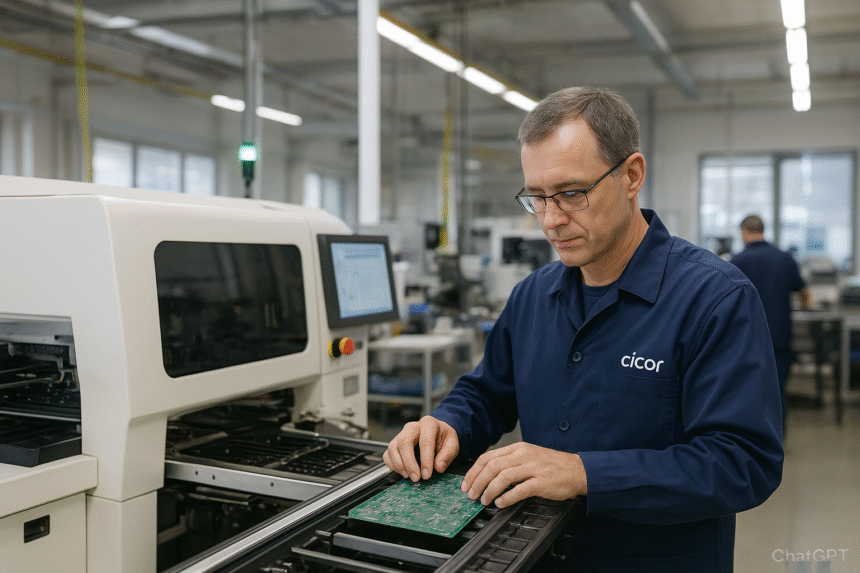If your audience searches for “Peter Bucher Cicor”, they’re usually looking for real-world operational leadership inside an electronics manufacturing services (EMS) company — someone who turned process-level problems into measurable improvements. This article explains Peter Bucher’s role and impact at Cicor, gives a clear picture of Cicor the company, breaks down the technical and business challenges they face, and shares compact case studies and practical lessons readers (engineers, procurement leads, operations managers) can use.
Who is Peter Bucher? A plain-language profile
Peter Bucher is known in industry circles as a senior operations leader at Cicor’s Bronschhofen site in Switzerland. In that role he has focused on improving incoming-goods handling, increasing traceability, and applying automation to reduce manual errors and speed up throughput — typical priorities for high-precision EMS sites where small components and strict traceability rules matter. Evidence of his role and interviews about the Bronschhofen operation appear in supplier success stories and site-focused pieces.
Why this is important: an experienced operations leader like Bucher is the bridge between engineering design and consistent, high-quality manufacturing — especially for customers in medical, aerospace or defence where traceability and quality are non-negotiable.
Quick overview: Cicor — the company in plain words
Cicor is a Swiss-headquartered group that provides full-cycle electronic solutions — from R&D and engineering to printed circuit boards (PCBs), assembly and supply-chain services. It serves medical, industrial and aerospace & defence customers and operates multiple sites globally. Recent corporate reporting indicates the company has thousands of employees across many countries and is growing through strategic acquisitions.
Key facts readers care about:
-
Cicor focuses on high-tech electronics and complex assemblies, not plain consumer gadgets. The group has continued expansion activity (for example, integrating assets from Eolane in 2025) to strengthen aerospace and defence capabilities.
Why combine a people profile (Peter Bucher) with company analysis (Cicor)?
Searchers who type “Peter Bucher Cicor” want narrative + practical detail. They expect:
-
Who the person is and how they operate day-to-day.
-
Concrete processes and tech choices used at Cicor.
-
Business context: why Cicor’s decisions matter to customers and partners.
This article blends those angles so it ranks for both informational and commercial-intent searches.
Core operational areas Peter Bucher focuses on (and why they matter)
Below are the main operational buckets often discussed in sources about Bronschhofen and similar Cicor sites. I’ve written them in simple, actionable language.
1. Incoming goods & goods receipt — first mile quality control
Problem: electronics production depends on tiny components; if the first check is sloppy, errors ripple through production.
What Bucher and teams improved: automation of incoming-goods registration, better barcode/ID scanning, and process mapping so received parts immediately become traceable to production batches. These changes reduce inspection time, speed materials availability, and prevent wrong-part assembly.
Business benefit: fewer production stoppages, fewer warranty claims, faster customer deliveries.
2. Traceability & compliance
Problem: customers in medical and aerospace need full traceability from PCB to final assembly.
What good practice looks like: digital records that link each component’s lot number through assembly steps and final test results (serial-number-level traceability), supported by scanning and integrated databases.
Business benefit: easier audits, faster recalls (if needed), and higher trust from regulated customers.
3. Automation & process digitization
Problem: manual handling is slow and error-prone for high-volume, mixed-model production.
What’s done: targeted automation where ROI is clear (goods receipt, high-frequency pick-and-place validation, test-data capture). Importantly, automation is combined with operator training so technology augments rather than replaces skilled workers.
Business benefit: higher output per shift, consistent quality, and measurable KPIs for shop-floor management.
4. Supplier collaboration & logistics resilience
Problem: modern supply chains face disruptions — shortages, shipping delays, customs friction.
What helps: closer collaboration with component suppliers, just-in-case stock policies for critical parts, and digitized supplier communication so substitutions or lead-time changes are visible early.
Business benefit: fewer line-down events and better on-time delivery performance.
Technical aspects: what technologies matter at Cicor’s EMS sites
Here’s a simple catalogue of the technical building blocks you’ll see in a modern Cicor-like EMS operation. Each item links to the operational priorities above.
-
ERP + MES integration — ties order data to the shop floor so manufacturing steps are scheduled and recorded.
-
Barcode / RFID scanning — enables component-level traceability on receipt and at assembly steps.
-
Automated optical inspection (AOI) & in-circuit test (ICT) — for fast, automated defect detection on PCBs.
-
Pick-and-place machines and reflow ovens — the physical backbone of SMT (surface mount) assembly.
-
Test jigs & functional testers — validate that assembled boards behave as intended before final assembly.
-
Warehouse automation & goods-receipt kiosks — speed up incoming logistics.
-
Data analytics & dashboards — convert machine and test data into actionable KPIs for operations leaders.
These technologies are effective when paired with disciplined process design and trained staff — the combination Peter Bucher and teams emphasize in published site stories.
Real challenges Cicor (and similar EMS firms) face — broken down simply
No operation is perfect. Here are recurring issues and practical ways leaders address them.
Challenge 1: Component shortages and single-source risks
Practical mitigation: multi-source components where possible, strategic safety stock for long-lead / critical parts, and design-for-sourcing conversations earlier in the product lifecycle.
Challenge 2: Complexity from mixed-product lines
Practical mitigation: cellular production layouts, quick-changeover tooling, and modular work instructions so teams can switch products fast while maintaining quality.
Challenge 3: Regulatory and export controls (aerospace/defence)
Practical mitigation: strict access control, compliance teams, and careful vendor screening.
Challenge 4: Balancing automation investment with variable volumes
Practical mitigation: invest in flexible automation (collaborative robots, software-driven inspection) and look for high-frequency, repeatable tasks where automation pays off.
How Cicor’s strategy links to market demand (short business view)
Cicor’s focus on medical, industrial, and aerospace markets is strategic: these industries pay premiums for reliability, documentation, and engineering support. By strengthening operations (people + process + automation), Cicor increases margins and can bid on higher-complexity projects — which is why acquisitions and integrating specialized facilities are logical moves. Recent reporting on company growth and acquisition activity shows Cicor actively expanding capabilities in aerospace and defence.
Practical takeaways for operations managers and procurement leads
If you run operations or buy EMS services, here are practical, bite-sized suggestions derived from the Cicor + Bucher story:
-
Start with goods receipt — small wins at the first touchpoint reduce downstream rework.
-
Make traceability business-friendly — build it into contracts and service-level agreements with your EMS vendor.
-
Invest where volume and error cost intersect — automation should target repetitive, high-impact tasks.
-
Plan for supplier disruptions — use multi-sourcing and early design choices to reduce single-point failures.
-
Measure operational KPIs consistently — cycle time from receipt-to-first-assembly, first-pass yield, and time-to-test are gold metrics.
FAQs
Q1: Who is Peter Bucher at Cicor?
A: Peter Bucher serves as a senior operations leader at Cicor’s Bronschhofen site, focusing on goods receipt, traceability, and shop-floor process improvements.
Q2: What does Cicor do?
A: Cicor provides full-cycle electronic solutions from R&D and PCB manufacturing to assembly and supply-chain services for medical, industrial, and aerospace sectors.
Q3: Has Cicor grown through acquisitions recently?
A: Yes — in 2025 Cicor moved to integrate parts of France’s Eolane business to strengthen aerospace and defence capabilities, among other strategic moves.
Q4: What operational improvements deliver the fastest ROI in EMS?
A: Improvements at goods receipt (faster, accurate registration), automated inspection (AOI/ICT) and test-data capture typically deliver fast, measurable ROI.
Q5: Can small EMS sites benefit from automation?
A: Yes — targeted, flexible automation for high-frequency or error-prone tasks often offers the best balance of cost and impact.
Conclusion
The story of Peter Bucher Cicor is less about a single person and more about how focused operational leadership converts technical tools into real commercial outcomes. Cicor’s model — combining engineering capability, disciplined shop-floor processes, and strategic growth — shows how EMS providers win repeat business from demanding industries. For readers who want to learn from that approach: start at the first touchpoint (incoming goods), make traceability non-negotiable, invest in flexible automation, and align supplier management with product design.
If you publish this on your blog, pair the article with one real photo from the shop floor, structured FAQ markup, and an internal link to any related posts you have about EMS, traceability, or supply-chain resilience. That will help your post be useful to readers and better positioned to attract traffic on SEMrush and Google.







